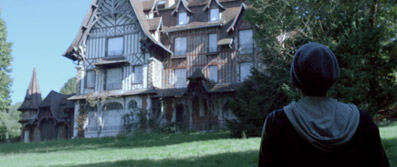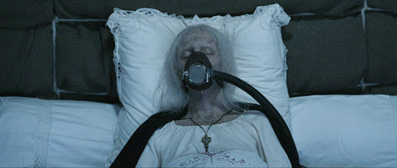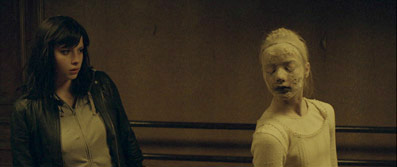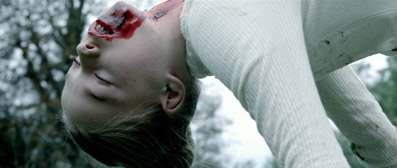|
The names Alexandre Bustillo and Julien Maury should be familiar to dedicated horror fans for their dark, claustrophobic and supremely violent 2007 debut Inside. Expectations were thus high for their belated follow-up feature, but the resulting film has provoked a somewhat mixed response. It's not hard to see why, for while there's much that is fine here, the film undergoes three distinct generic shifts in the course of its run time. The first is expected (it's what the film's sold on, after all), the second takes us into surprisingly familiar territory, and the third... well, the third really is the one that'll either have you captivated or reaching for your head-scratcher and emotionally tuning out.
It all begins in intriguingly understated manner, with young Lucie spending her first day as a care worker being taken on a tour of her home-bound patients by old hand Catherine. When they arrive at the gates of a run-down and isolated manor house, however, Catherine advises Lucie to wait in the car with the assurance that she's not quite ready for this one. After sitting for a while, the curious Lucie wanders inside anyway and finds Catherine in the bedroom of the house owner Mrs. Jessel, a celebrated former dance teacher who is now in a cerebral coma and who has stipulated that she wishes to die at home. Rather than admonish Lucie, Catherine is actually impressed by her persistence, and in the course of telling her more about their most special patent, casually reveals that the old woman is reputed to have a large fortune hidden somewhere in the house.

That evening Lucie meets up with her boyfriend William and his brother Ben, and in the course of telling them about her first day she recalls her visit to the Jessel house and the rumours about the old woman's hidden fortune. It's at this point that William's ears really prick up. In no time at all, he and the equally cash-strapped Ben are proposing that the three of them break into the Jessel house at night to hunt out and steal the fabled treasure. Lucie is initially hostile to the idea, but a quick refresher course in her own miserable home life prompts a reluctant change of mind. Getting in eventually proves straightforward enough, and after an initially fruitless search they locate where they believe the treasure is probably hidden, but their discovery appears to awaken a mysterious and potentially malevolent force.
Before I go on, I'd just like to say what a pleasure it is to watch a horror movie where the filmmakers have actually hired a tripod and a dolly and employed a camera operator who is not suffering from a chronic nervous condition. I also salute any genre movie that doesn't feel the need to start with a loud bang, a trick regularly employed to assure a short attention span audience that the horror is definitely coming if they can just sit still for a few minutes of scene setting and character introductions. Livid instead takes a little time to establish the social situation out of which the horror will grow, one as convincingly outlined as that in any even half-decent regular drama. Thus while the decision to break into the Jessel house may be rapidly made, it is at least born of perceived financial need rather than the usual teen foolhardiness. This gentle air of realism also makes the film's first curve ball – one involving Catherine and not included in the above synopsis – all the more jarring. When you present an audience with an obvious monster then they're not going to be surprised when they do monstrous things, but when that monster has the look and demeanour of a cheerful auntie, the effect is considerably more disconcerting.
The house interior takes the film into old school gothic horror territory, all dark corridors and landings, decay and Victorian décor, with the woman upstairs, despite her comatose state, a constant reminder that the trio of young intruders are never truly alone. It's an atmospheric build-up to the slip into horror that the pre-publicity has assured us is coming, one spookily telegraphed when the three prepare to embark on their mission and are confronted by the genuinely unnerving image of a small party of slowly advancing children in full Halloween costume. Yes, it's Halloween night, the first indication that genre convention may be set to play a bigger part in what follows than pre-release word had led us to believe.

And here lies my difficulty. A fair few viewers appear to have been genuinely frightened by what follows and that's fair enough. I have to confess that I was not, and as a seasoned horror fan I instead found myself struggling to marry the film's sometimes poetic handling with its fractured internal logic and occasional dips into genre cliché. But to talk about why would require revealing plot details that first-timers should ideally not to know in advance (and if that includes you, then be careful of which other reviews you read, as some have gone ahead and revealed these plot points anyway). Thus I'll confine such discussion to the following paragraph, and if you want to avoid spoilers then hop forward to the paragraph that follows (or simply click here, which should scroll the page down).
For me, the first real stumble comes when the trio unlock the door to the room they are convinced holds the treasure and are confronted instead with the veiled and suspended body of Jessel's long-dead daughter. Furious at not finding the material wealth he assumed was hidden here, William responds by punching the body so hard in the face he appears to snap its neck. It's here that the trio's troubles really begin, as something or someone starts stomping about upstairs (no real surprises who). The problem is that this angry response feels like exactly what it is, a written-in trigger that does not feel natural to the character or situation. This is not the action of a frustrated and disappointed young man on a treasure hunt, but sort of thing the stock idiot jock of too many dumbass American teen horrors would do. That mother and daughter turn out to be vampires – the sort that snarl, leap forward and chaw on your head – is also a bit of a let down, a modern-day horror movie monster too-familiar for those even moderately well versed in the genre. And having a mirror that can teleport Ben (who reaches out to touch it for no other reason than that's the sort of thing people do in genre movies) to another otherwise inaccessible room feels almost as if it's wandered in from a different sub-genre. That he's then set upon by three ghostly child dancers, whose solidity and brutality gives their assault the overtones of a violent street beating is genuinely disturbing, particularly given the young age of the attackers, but there remains the niggling sense that genre and story logic have been put on pause to allow the staging of a visually creative and memorable death.

Atmospheric though this all may be, these scenes never come close to the sheer ruthless intensity and claustrophobic threat that made Inside such a punishing experience. The knock-on effect, at least for this humble viewer, was that my bond with Lucie (I'd spent too little time with her companions to have any real emotional investment there) soon began to falter and I found myself observing rather empathising with her plight. This gradual disconnection is completed by a final act that unexpectedly transforms the film into a dark fairy tale, which while visually arresting and bold in concept, is too radical a departure from what has gone before to engage on anything approaching an emotional level.
There's no denying that Livid is a worthy and often stylish attempt to rethink the standard horror formula and deliver a film that challenges our expectations and takes us in unexpected and interesting directions. Real thought has gone into the execution of specific scenes and the underlying substructure, particularly the manner in which elements are subtly bonded by the number 3, whether it be the party of young housebreakers, the number of people in a location in specific sequences, or the three kids in Halloween costume who give the group such a start, their pantomime menace having a deadly echo in the three ghostly children who later attack Ben. All of which results in a film that engages more on an intellectual than emotional level, one I found myself repeatedly admiring for its ideas and execution instead of peeking through my fingers at in fear as I'd hoped.
A crisp, impressively detailed 2.35:1 anamorphic transfer with nicely balanced contrast and daytime colours that have not been seriously messed with in post-production, which makes nice change. Pleasingly, the picture integrity is maintained even when the light levels drop, and despite some perhaps inevitable colour tinting, clarity is almost never an issue.

The choice between Dolby 2.0 stereo and Dolby 5.1 surround is an easy one here – the surround track is richer, more inclusive and boasts a better bass response. The use of the full sound stage also adds considerably to the atmosphere once the house turns on its visitors.
It's worth noting up front that there are spoilers in almost all of the extra features here, so they really should watched after seeing the film.
Behind the Scenes (17:19)
A commentary-free and unstructured collection of behind-the-scenes footage of varying length showing the directors and performers preparing for, rehearsing and shooting of a number of sequences. Some brief makeup work is also captured.
Interviews:
Julien Maury & Alexandre Bustillo (5:50)
The two co-writer-directors talk briefly about their desire to create a dark adult fantasy, and chat more expansively about their discovery and subsequent passion for the horror genre.
Marie-Claude Pietragalla (7:53)
Acclaimed dancer and choreographer Marie-Claude Pietragalla recalls working on the film and playing the role of Mrs. Jessel, particularly the sometimes claustrophobic experience of having to endure hours in the old woman makeup.
Catherine Jacob (3:24)
Actress Catherine Jacob talks about her work on the film, the appeal of its fantasy elements, and how the role of Catherine was like a breath of fresh air. She also suggests that the two directors are like imaginative 28-year-old children.
Felix Moati & Jeremy Kapone (3:37)
The two young male actors who play William and Ben talk about their characters, their experience on the film and the pleasures of working with respected performers like Catherine Jacob and Marie-Claude Pietragalla.
Trailer (1:33)
A misleadingly loud and slam-bang trailer that suggests a far more conventional and incident-driven work.
An intriguing, chance-taking and visually arresting follow-up to one of the darker horror experiences of recent years that has captivated some but didn't completely work for me, despite an intriguing first half-hour and some captivating sequences. Still well worth a look if you're searching for something a little outside of the genre norm, and Maury and Bustillo are still clearly worth watching. The extras on Studiocanal's DVD are a little light on substance but still worthwhile, and the transfer is first rate, boding very well for the Blu-ray edition.
|